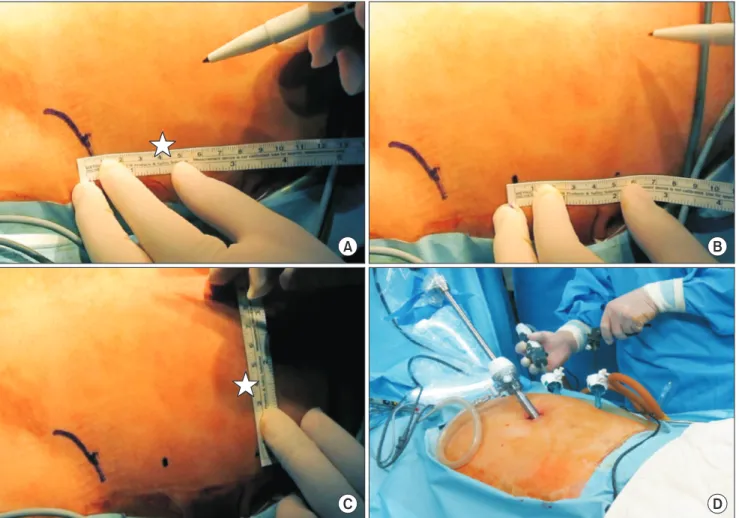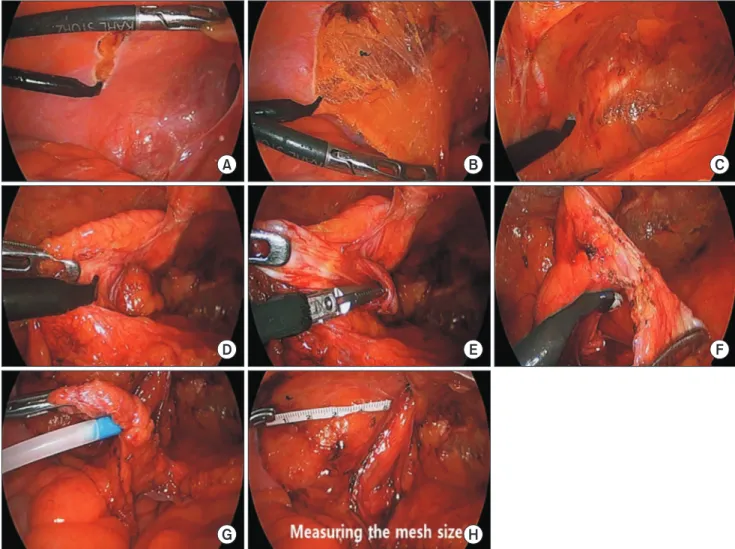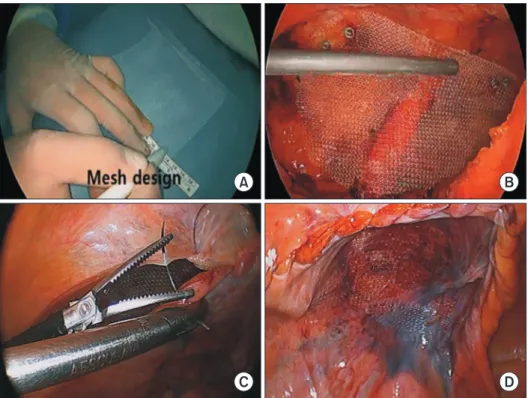Left Side Approach in Laparoscopic Transabdominal Preperitoneal Inguinal Herniorrhaphy is Feasible for Any Type of Inguinal Hernia
전체 글
(2) 119. Ipsilateral TAPP. A. B. C. D. Fig. 1. (A) First 5-mm operative trocar was placed at the left midaxillary line, 4 cm upward from the anterior superior iliac spine. (B, C) Second 5-mm operative trocar was placed in 4~5 cm in a cephalic direction from the previous operative trocar and 4 cm medially from midaxillary line. (D) Operation is performed at the patients’ left side regardless of hernia location. because of the need for access to both sides and a surgical dissection area from the symphysis pubis to the anterior superior iliac spine. However, this can be unergonomic and uncomfortable for some surgeons, especially those with a shorter reach. In this situation, it would be preferable to operate with two ipsilateral trocars. For this reason, we introduce the only left side approach TAPP (L-TAPP) procedure, which approach through an ipsilateral trocar position on the patient’s left side, regardless of the side of the hernia, and discuss the initial results. The goal of this study is not to demonstrate the superiority of only left side approach TAPP compared to conventional TAPP, but to confirm the possibility of L-TAPP as a new surgical technique to maximize the convenience of surgeon. To do this, we compare L-TAPP with TEP which is the most common surgical method now.. MATERIALS AND METHODS We included patients who underwent laparoscopic inguinal hernia repair by a single surgeon between April 2016 and August 2017 in a single institution. The patients were divided into TEP and L-TAPP groups and compared with respect to clinical characteristics and surgical outcomes. The patient characteristics included age, sex, body mass index (BMI), type and location of hernia, and recurrent hernia status. The operative time, postoperative complications, and early recurrence were documented. In addition, surgical outcomes were compared according to the location of hernia among L-TAPP group. This study was approved by institutional review board (IRB number: PC17REDI0055).. Operative procedure With the patient supine, a 10-mm optical trocar was placed. www.e-jmis.org.
(3) 120. Hyung jin Cho and Dong Jin Kim. A. B. C. D. E. F. G. H. Fig. 2. (A) The peritoneum was incised from anterior superior iliac spine level to median ligament. (B) Preperitoneal space was dissected with sharp and blunt dissection using electrocautery device with angled tip. (C) Preperitoneal dissection was done to expose pubic bone and inferior epigastric vessel. (D, E) Hernia sac was dissected, and vas deference and spermatic vessels were dissected from hernia sac. (F, G) Dissected hernia sac was ligated with endoloop. (H) Measuring the mesh size with 5 cm ruler intra-corporeally. in the umbilicus; a 5-mm operative trocar was placed at the left midaxillary line, 4 cm upward from the anterior superior iliac spine (ASIS) (Fig. 1A), and a 5-mm operative trocar was placed in 4~5 cm in a cephalic direction from the previous operative trocar and 4cm medially from midaxillary line (Fig. 1B & C). This trocar placement is most optimal position to avoid impingement between right and left-hand instruments (Fig. 1D). The L-TAPP procedure commenced with the patient in Trendelenburg position. All the L-TAPP were performed at the patients’ left side regardless of hernia type and location. Due to the angle between the operative trocars, there are no difficulties in repairing a right inguinal hernia. Although there was slight difficulty with a left inguinal hernia due to the angle between the trocars, careful crossing of the grasper will. Journal of Minimally Invasive Surgery Vol. 21. No. 3, 2018. permit completion of the surgical procedure without difficulty. The operative procedure is as follows. First, the peritoneum was incised (Fig. 2A) in an up to down direction with repeated sharp and blunt dissection using electrocautery device with angled tip (Fig. 2B). While peritoneal dissection is performed, we could find inferior epigastric vessels, cooper ligament and external iliac vessels (Fig. 2C). The dissection was done until the symphysis pubis and pubic bone on the medial side, and the ASIS on the lateral side, were adequately exposed. After identifying the hernia sac and cord structure entering the internal ring (Fig. 2D), the hernia sac was isolated from the spermatic cord and vessels (Fig. 2E). And the hernia sac was resected and ligated using an endo-loop when sac is perforated (Fig. 2F & G). After measuring the defect size using a ruler (Fig. 2H),.
(4) 121. Ipsilateral TAPP. A. B. C. polypropylene mesh was designed (Fig. 3A) and inserted through the optical trocar. After placing the mesh to adequately cover the internal ring and Hesselbach’s triangle, the medial side was fixed to Cooper’s ligament, and the lateral side was fixed near the ASIS using a tacker (Fig. 3B). Then, the peritoneum was closed using V-loc suture (Medtronic, Minneapolis, MN, USA) (Fig. 3C & D).. Statistical analysis Statistical analyses were performed with SPSS 18.0 (IBM, Chicago, IL). The collected data were expressed as median, frequency, percentage, and mean±standard deviation (SD). The chi-square test or Fisher’s exact test, and Student’s t-test were used for comparisons. Statistical significance was set at p<0.05.. RESULTS Of 44 patients who underwent laparoscopic herniorrhaphy, 33 underwent TAPP and 11 underwent TEP (Table 1). There were 31 males and 2 females in the TAPP group and 10 males and 1 female in the TEP group (p=0.730). Patient ages ranged from 18 to 88, with a mean age of 67.5 in the TAPP group and 58.1 in the TEP group (p=0.068). The mean BMI was similar between the two groups (TAPP group vs. TEP group=23.7± 3.4 vs. 23.6±2.7, p=0.959). Ten patients had prior abdominal surgery in TAPP group, six patients in TEP group and five patients had a prior herniorrhaphy (recurrent hernia) in the. D. Fig. 3. (A) Designing mesh according to measured size. (B) Mesh fixation with tacker. (C) Peritoneum closure with unidirectional braided suture material. (D) Final view of operation site.. TAPP group alone (p=0.170). Five in the TAPP group and one in the TEP group had a bilateral hernia. There were no differences in surgical outcomes between the two groups (Table 1). Mean operative time for TAPP was 71.4 ±20.5 min, and 75.8±17.4 min for TEP (p=0.522). However, the mean operative time for a unilateral hernia repair only was 66.9±17.9 min for TAPP and 72.9±15.2 min for TEP (p=0.349). The mean length of hospital stay for the TAPP group was 2.5 ±0.7 days and 2.5±0.5 days for the TEP group (p=0.797). And the mean length of hospital stay for a unilateral hernia in the TAPP group was 2.5±0.6 days and 2.5±0.5 days for the TEP group (p=0.860). In the case of subgroup analysis divided into three groups according to the direction of the hernia in L-TAPP group, there was no significant difference about surgical outcome except for operation time (p=0.007) (Table 2). However, it was meaningful only in the comparison of the left side and both sides (p=0.003), right side and both side (p=0.004), and there was no statistical meaning in the comparison of the left side and the right side (p=0.881). There was one postoperative scrotal hematoma and cord edema in the TEP group, but this was not statistically significant (p=0.219). No complication was observed in the TAPP group. There were no early recurrences in either group.. DISCUSSION Open inguinal hernia repair had been the standard treatwww.e-jmis.org.
(5) 122. Hyung jin Cho and Dong Jin Kim. Table 1. Clinicopathologic characteristics between L-TAPP and TEP Variables. L -TAPP (n=33). TEP (n=11). p. Sex. Table 2. Clinicopathologic characteristics of the three group according to direction Variables. Left (n=13) Right (n=15) Both (n=5). p. Sex. Male Female Age (yr). 31 (93.9). 10 (90.9). 2 (6.1). 1 (9.1). 67.5±13.2. Body weight (kg). 64.6±10.6. 58.1±17.4 66.2±11.1. 0.730 0.068 0.511. 23.7±3.4. 23.6±2.7. 0.959. ASA classification 2. 22 (66.7). 6 (54.5). 3. 3 (9.1). 2. ASA classification. 166.9±7.6. 5 (45.5). Age (yr) BMI (kg/m ). 165.3±6.9. 8 (24.2). 0 (0). 0.964. 2. 1. 13 (100). Female. Height (cm) BMI (kg/m ). Male. 0.294. 0 (0). 65.4±17.0 67.7±10.2. 72.0±5.0. 0.655. 22.9±4.2. 23.6±0.6. 0.569. 24.3±3.1. 3 (23.1). 3 (20.0). 2 (40.0). 2. 8 (61.5). 11 (73.3). 3 (60.0). 3. 2 (15.4). 1 (6.7). 0 (0). Direct. 2 (15.4). 5 (33.3). 5 (100). Indirect. 11 (84.6). 8 (53.3). 0 (0). 5 (15.2). 1 (9.1). Right. 15 (45.5). 5 (45.5). Left. 13 (39.4). 5 (45.5). Recurrent hernia. 0.862. Operation time (min). Hernia type Direct. 12 (36.4). 3 (27.3). Indirect. 19 (57.6). 8 (72.7). Femoral. 1 (3.0). 0 (0). Pantaloon. 1 (3.0). 0 (0). 5 (15.2). 0 (0). 0.170. 0.759. 0.852. Include Bilateral. 71.4±20.5. 75.8±17.4. 0.522. Except Bilateral. 66.9±17.9. 72.9±15.2. 0.349. Include Bilateral. 2.5±0.7. 2.5±0.5. 0.797. Except Bilateral. 2.5±0.6. 2.5±0.5. 0.860. 0 (0). 1* (9.1). 0.219. Hospitalization days. L-TAPP = Left side approach transabdominal pre-peritoneal repair; TEP = Totally extrap eriton eal repair; BMI = Body mass index; ASA = American society of the anes thesiologist classification. *Scrotal hematoma and cord swelling. ment of choice for over a century. After laparoscopic technique was introduced for cholecystectomy and appendectomy, TEP and TAPP procedures were also introduced. Since then, many comparative studies have been performed between laparoscopic and conventional open repair.6-8 In those studies, laparoscopic inguinal herniorrhaphy is preferred because. 0.006. Femoral. 0 (0). 1 (6.7). 0 (0). Pantaloon. 0 (0). 1 (6.7). 0 (0). 1 (7.7). 2 (13.3). 2 (40.0). 0.262. 66.3±12.1 67.3±22.2. 96.6±16.1. 0.007. Hospitalization days. Operation time (min). Journal of Minimally Invasive Surgery Vol. 21. No. 3, 2018. 0.631. 0 (0). 1. Both. Complication. 2 (13.3%). 5 (100). Hernia type. Direction. Recurrent hernia. 13 (86.7). 2.5±0.7. 2.5±0.5. 2.2±1.3. 0.639. Conversion. 0 (0). 0 (0). 0 (0). -. Complication. 0 (0). 0 (0). 0 (0). -. BMI = Body mass index; ASA = American society of the anesthesiologist classification. of shorter hospitalization, rapid return to usual activity, less pain, and cosmetic benefits. In addition, there is no difference between open and laparoscopic repair regarding short-term recurrence. Among laparoscopic inguinal hernia repair technique, TAPP and TEP are widely used surgical methods for inguinal hernia repair. TEP has a major advantage in not entering the peritoneal cavity, but TEP is technically difficult, with a longer learning curve. Moreover, the operator has difficulty due to the limitations of space and the unfamiliar anatomical structure especially for the patients underwent previous intraabdominal surgery.9 In contrast, TAPP has a major disadvantage by entering the peritoneal cavity, with a risk of injury to abdominal organs and to inducing postoperative adhesions. However, operator can perform the surgery with sufficient and familiar space. In addition, pre-peritoneal adhesion induced by previous intra-abdominal surgery can be dealt with more.
(6) 123. Ipsilateral TAPP. efficiently. In general, the preferred method for TAPP placed the optical trocar in the umbilical position and the other two operative trocars in the contralateral midclavicular line. This is probably because of the need for access to both sides and a surgical dissection area from the symphysis pubis to the ASIS. However, this method can be inconvenient and unergonomic for some surgeons who have short reaches. For them, if it is possible to manage both side of inguinal hernia, the ipsilateral operative trocar placement could be more convenient and ergonomic procedure. In this study, we presented our new trocar placement and method for only left side TAPP approach. To the best of our knowledge, this is the first report to consider the usefulness of ipsilateral trocar position for laparoscopic TAPP. To prove real benefit of only left side approach of TAPP, this new procedure had to be compared with conventional contralateral TAPP method. However, because previous TAPP procedures were mainly used for recurrent inguinal hernia, comparative study between L-TAPP and conventional TAPP was impossible. Instead, comparative analysis was done with TEP which is most widely performed laparoscopic hernia repair procedure. Although the number of cases is low, there was no difference between the TAPP method and the TEP method in terms of complications, hospital days, and early recurrence. However, there were 5 (12.5%) bilateral and 5 (12.5%) recurrent cases in TAPP group. These difference in characteristics of two groups reflect advantage of TAPP regarding the recurrent inguinal hernia and bilateral hernia. All those surgeries were successfully performed by patients’ left side ipsilateral approach. Conceptually, left inguinal hernia seem to be difficult to manage with left side ipsilateral approach. However, laparoscopic TAPP can be successfully done with proposed trocar placement and angled electrosurgery tip. Recently, the number of reports related to robotic hernia repair has increased, probably because interest in robotic surgery has increased.10,11 Reasons to increase the number of robotic hernia repairs include not only the detailed movement and superior imaging, but also physical convenience.12 Thus, we thought that this ipsilateral operative trocar method would be more convenient than the conventional contralateral operative trocar method; moreover, the surgical cost is much lower, compared to the cost of robotic hernia repair. The limitation of this study is that the ergonomics of this procedure were not validated by other surgeons. We did not assess the comfort of this procedure using an objective scale. Only the operating surgeon perceived a feeling of comfort. For. this reason, further study and external validation are needed. In conclusion, L-TAPP is a feasible and safe procedure compared with TEP. In addition, this procedure might be adopted with more comfort for surgeons who have short reaches.. REFERENCES 1) Sakorafas GH, Halikias I, Nissotakis C, et al. Open tension free repair of inguinal hernias; the Lichtenstein technique. BMC Surg 2001;1:3. 2) Simons MP, Aufenacker T, Bay-Nielsen M, et al. European Hernia Society guidelines on the treatment of inguinal hernia in adult patients. Hernia 2009;13:343-403. 3) McCormack K, Wake BL, Fraser C, Vale L, Perez J, Grant A. Transabdominal pre-peritoneal (TAPP) versus totally extraperitoneal (TEP) laparoscopic techniques for inguinal hernia repair: a systematic review. Hernia 2005;9:109-114. 4) Gass M, Banz VM, Rosella L, Adamina M, Candinas D, Guller U. TAPP or TEP? Population-based analysis of prospective data on 4,552 patients undergoing endoscopic inguinal hernia repair. World J Surg 2012;36:2782-2786. 5) Moldovanu R, Pavy G. Laparoscopic Transabdominal Pre-Peritoneal (TAPP) procedure-step-by-step tips and tricks. Chirurgia (Bucur) 2014;109:407-415. 6) EU Hernia Trialists Collaboration. Laparoscopic compared with open methods of groin hernia repair: systematic review of randomized controlled trials. Br J Surg 2000;87:860-867. 7) Chung RS, Rowland DY. Meta-analyses of randomized controlled trials of laparoscopic vs conventional inguinal hernia repairs. Surg Endosc 1999;13:689-694. 8) Memon MA, Cooper NJ, Memon B, Memon MI, Abrams KR. Meta-analysis of randomized clinical trials comparing open and laparoscopic inguinal hernia repair. Br J Surg 2003;90:1479-1492. 9) Brandt-Kerkhof A, van Mierlo M, Schep N, Renken N, Stassen L. Follow-up period of 13 years after endoscopic total extraperitoneal repair of inguinal hernias: a cohort study. Surg Endosc 2011;25:1624-1629. 10) Escobar Dominguez JE, Ramos MG, Seetharamaiah R, Donkor C, Rabaza J, Gonzalez A. Feasibility of robotic inguinal hernia repair, a single-institution experience. Surg Endosc 2016;30:4042-4048. 11) Iraniha A, Peloquin J. Long-term quality of life and outcomes following robotic assisted TAPP inguinal hernia repair. J Robot Surg 2018;12:261-269. 12) Kudsi OY, McCarty JC, Paluvoi N, Mabardy AS. Transition from Laparoscopic Totally Extraperitoneal Inguinal Hernia Repair to Robotic Transabdominal Preperitoneal Inguinal Hernia Repair: A Retrospective Review of a Single Surgeon’s Experience. World J Surg 2017;41:2251-2257.. www.e-jmis.org.
(7)
수치



관련 문서
This same argument can be used to show that the complementary virtual work of redundant member forces is zero not only for truss elements but for members of any other
Therefore depending on the size of the fracture in the veneering porcelain, intraoral repair methods using surface treatment and composite resins may
Although the coastal area of Jeju has already been developed, it has high pressure and demands for development continually increasing due to the increase
This study is based on the fact that demand for housing has been under the influence of change of population structure... people live in
Construction New construction sites, road repair sites, demolition of buildings.
In this study we will survey the changes in DNA repair factors during aging in rat, including mismatch repair (MMR), base excision repair (BER), and double-strand break
Patient had laparoscopic surgery on the adnexal tumor and excised tissue was removed through Douglas pouch incision by single surgeon.. Results: The mean age
To investigate the levels of mismatch repair proteins, such as MSH2, MSH6, MSH3, MHL1, and PMS2, in young, intermediate and senescent CCD-18Co and IMR90 cells,